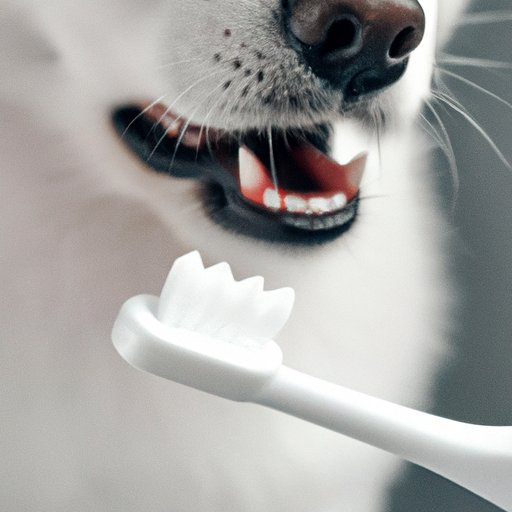
Introduction
Dental health is critical for your dog’s overall wellbeing. The health of their teeth and gums can impact their ability to eat, play, and socialize. Brushing your dog’s teeth is one of the most effective ways to maintain their dental health. In this article, we’ll provide tips on how to brush your dog’s teeth effectively, step-by-step.
Choose a Suitable Toothbrush and Toothpaste for Your Dog
The first step in brushing your dog’s teeth is to choose the right toothbrush and toothpaste. It’s essential to select a toothbrush that is appropriately sized for your dog’s teeth and gums. Small dogs require smaller toothbrushes, while bigger dogs may need larger brushes. You may also choose from different softness levels of bristles depending on the sensitivity of your dog’s teeth.
When selecting a toothpaste, it’s crucial to pick one that is specifically designed for dogs. Human toothpaste contains fluoride that can be poisonous to dogs when ingested. Dog toothpaste typically comes in a variety of flavors and can be a helpful tool in getting your pup excited for teeth-brushing time.
Slowly Introduce Brushing to Your Dog
The best way to start introducing your dog to teeth-brushing is gradually. You don’t want to overwhelm your dog and create a negative association with the process. Start by getting your dog comfortable with the idea of having their mouth touched. You can do this by gently massaging their gums and teeth using your fingers.
Next, introduce your dog to the toothbrush and toothpaste. Rub a small amount of toothpaste onto your finger and allow your dog to lick it off. This will help them become familiar with the taste. Then, place a small amount of toothpaste on the toothbrush and allow your dog to sniff and lick it. Do this for a few days until your dog is comfortable with the toothbrush being in their mouth.
Demonstrate the Proper Brushing Technique
When you start brushing your dog’s teeth, it’s crucial to follow the right technique. Begin by lifting your dog’s lip and brushing their front teeth gently. Set the toothbrush at a 45-degree angle and move it in small circular motions. Ensure the bristles reach the gum line, where plaque can build up.
As you work backward along the teeth, angle the brush up to clean the top of the molars. Be gentle but firm, and avoid brushing too hard or too fast, which may cause your dog to become stressed or anxious. Be sure to clean both the outside and inside surfaces of your dog’s teeth and gums.
Consider Offering Rewards
Positive reinforcement can be a powerful tool in helping your dog get used to brushing their teeth. Consider offering them treats or rewards after an effective brushing session. Praise and playtime are other positive rewards to give your dog. Over time, your dog will begin to associate teeth-brushing with a positive experience.
Focus on Consistency
One of the most critical factors in maintaining your dog’s dental health is to establish a consistent brushing routine. Ideally, you should brush your dog’s teeth daily. However, even just a few times a week can make a significant difference. Stick to the same time of day and reward your dog for tolerating teeth-brushing consistently.
Provide Tips for Overcoming Common Challenges
Brushing your dog’s teeth can be challenging, especially for first-time dog owners. Some common challenges include your dog being resistant, biting the toothbrush, or refusing to open their mouth. Some effective strategies to overcome these challenges include using calming voice patterns, choosing the right time and place for brushing, and providing familiar distractions, such as a toy or treats, during the brushing session.
Highlight the Importance of Regular Dental Check-ups
Even with the best brushing habits, your dog may still require professional dental care. It is essential to schedule routine dental check-ups with your veterinarian. They can identify any signs of dental disease or other oral health issues and create a customized plan for your dog’s dental care.
Conclusion
Brushing your dog’s teeth is an important aspect of their overall health care and should not be overlooked. By using the right toothbrush, toothpaste, and introducing the brushing technique properly, you can help to maintain your dog’s dental health and wellbeing. Positive reinforcement, consistency, and scheduling routine dental check-ups are essential for your dog’s dental care. By following these tips, you can enjoy happy, healthy smiles on your furry friend and a lifetime of shared moments together.





